Attitudes to Mental Health in Scotland: Scottish Social Attitudes Survey 2013
Report on public attitudes to mental health, based on data collected in the 2013 Scottish Social Attitudes Survey, and comparison with data collected through four previous surveys between 2002 and 2008.
This document is part of 2 collections
2 Personal and Indirect Experience of Mental Health Problems
2.1 This chapter explores both respondents' own personal experience of mental health problems and their experience of others' mental health problems. People were asked what types of mental health problems they had personally experienced and whether they knew someone with experience of mental health problems. The chapter also examines the extent to which people tell others about any mental health problems, and the impacts that prejudice and discrimination have on the lives of those with such conditions.
2.2 In more detail this chapter covers:
- Whether people know someone close to them who has, or has ever had, a mental health problem and if so the type(s) of mental health problem someone they know has experienced
- Personal experience of mental health problems, the type of mental health problem(s), and how these varied across socio-demographic groups
- Whether people have told others about their mental health problem, who they have chosen to tell, and how these varied by socio-demographic factors and type of mental health problem they have
- What impacts, if any, other people's attitudes to their mental health problems have had on their lives, and how these varied by socio-demographic factors and levels of life satisfaction[18] .
2.3 All of the questions discussed in this chapter were previously asked on the Well? What do you think? surveys (hereafter referred to as the 'Well? surveys'). This chapter explores, where possible, any significant changes that have occurred over time. As was noted in Chapter 1 (Para 1.25) any changes over time should be treated with caution given the change from a face-to-face methodology (2002-2008) to self-completion in 2013. Note that no direct comparisons can be made between the SSA 2013 responses and published Scottish prevalence data for mental health conditions (NHS Health Scotland, 2012). This is because there is a lack of comparability arising from the substantial methodological differences in how the data have been collected through different mechanisms.
Knowing someone with a mental health problem
2.4 Around two-thirds of people said they knew someone who had 'ever experienced a mental health problem' (65%), a similar proportion as in the 2006 and 2008 Well? surveys. All respondents were then asked whether they knew anyone with one of a wide range of fifteen specific mental health 15 conditions which were listed[19]. A higher proportion (79%) then said that they knew someone with at least one of the listed mental health problems. This higher proportion who knew someone with a problem when they were able to choose from the list suggests that people may be unaware of the wide range of conditions which fall under the general umbrella term of 'mental health problems'.
2.5 Half said they knew someone who had experienced depression (51%) and nearly a third knew someone with dementia (30%). Over a quarter knew someone who had experienced panic attacks (27%) and slightly under a quarter knew someone who had an anxiety disorder (23%). The next most commonly chosen mental health problems that people knew someone with were severe stress (17%), post-natal depression (16%), nervous breakdown (15%), manic depression (14%) and eating disorders (13%) (see Table A.1 in Annex A).
2.6 Comparing the figures from 2008 and 2013 (Figure 2.1 below) shows that there has been a significant increase in the proportion of people who know someone with depression, from 45% in 2008 to 51% in 2013. There has also been an increase of 8 percentage points in the proportion knowing someone with dementia, from 22% in 2008 to 30% in 2013 and a 10 percentage point increase in those knowing someone with an anxiety disorder (23% in 2013 compared with 13% in 2008). Figures from 2002 to 2008 did not show any increase in the proportion who knew people with these specific conditions, so the increase between 2008 and 2013 is not part of a longer term trend, but is a significant change in the last five years.
2.7 It is not clear why more people in 2013 reported that they knew someone with depression, dementia and anxiety disorders than in 2008. As noted above, there is no consistently reliable information available for Scotland on trends in the prevalence of these specific conditions, so it is not possible to conclude that this increase is directly related to increasing prevalence in the population. However, the main conclusion from the most recent overview report of Scotland's (adult) mental health is that 'the picture over the last decade can be summed up as broadly stable' and more specifically, that the indicator for 'common mental health problems' has shown no significant change over time (NHS Health Scotland, 2012). The increase in knowing someone with one of the listed conditions may be due to a range of factors including: more people being willing to seek help; improvements in diagnosis; more willingness to disclose to others; and better understanding among the general public.
2.8 This increase could potentially have a positive impact on stigmatising attitudes towards people with depression, dementia and anxiety disorders. Previous research carried out on SSA as part of a module on stigmatising attitudes (Ormston et al, 2011) showed that people who know someone with a mental health problem were less likely than those who do not to hold stigmatising attitudes towards them.
Figure 2.1: Experience of mental health problems in someone you know (2008 & 2013)
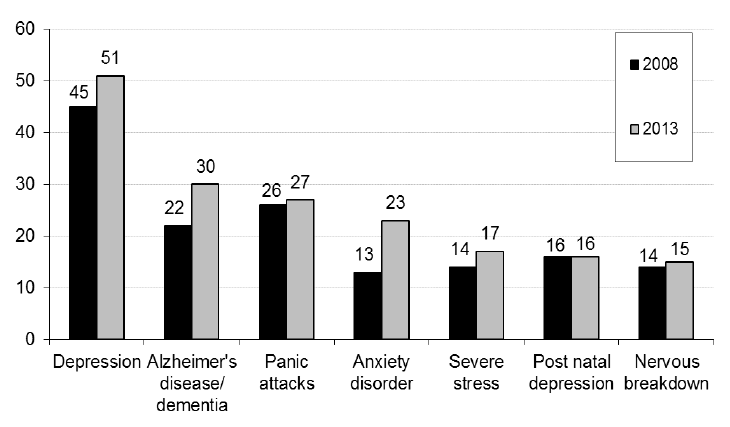
Base: All respondents
Sample size: 2008=1,177; 2013=1,497
Personal experience of mental health problems
2.9 A quarter of people (26%) said they had personally experienced a mental health problem at some point in their life time. This is consistent with previous Well? surveys, where the proportion ranged between 26%-28% from 2002 to 2008. However, when people were asked whether a doctor or health professional had ever told them they had a specific mental health problem, chosen from a list of 15 different types, 32% of people identified themselves as having at least one of these problems. This increase (from 26% to 32%) is consistent with the finding discussed in Para 2.4 above in relation to the findings on the extent of mental health problems experienced by 'someone you know'. In what follows, our analysis focuses on this larger group (32%). Therefore the remainder of this chapter is based on an analysis of 417 responses. Note that the smaller sample size has an impact on the sub-group analysis which is possible.
2.10 The most commonly cited mental health problem people had experienced was depression, with around 1 in 5 people (21%) saying they had experienced depression at some point in their lives (Figure 2.2 below). The next most common mental health problems were panic attacks (9%) and anxiety disorders (8%). These were also the three most commonly mentioned problems in the 2008 Well? report (for full details see Table A.2 in Annex A). However, the proportion of people who said they had depression increased from 17% in 2008 to 21% in 2013 and the proportion who said they had been told they had an anxiety disorder increased from 4% in 2008 to 8% in 2013. If the different types of anxiety and stress disorders listed are combined together[20], we found that 15% of people said they had an anxiety or stress disorder. This is an increase from 11% in the 2008 Well? survey.
Figure 2.2: Personal experience of mental health problems (2008 & 2013)
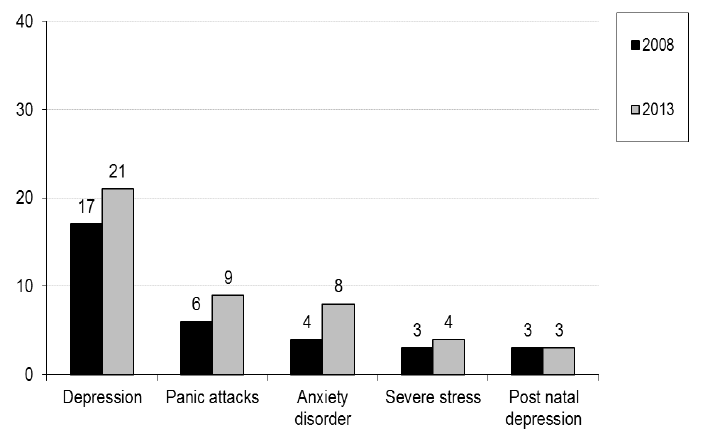
Base: All respondents who identified as having a mental health problem.
Sample size: 2008=359; 2013=417
2.11 There were some significant variations in the prevalence of mental health problems between different socio-demographic groups, in particular gender, age and income (for full details see Table A.3 in Annex A). Women were more likely than men to say they had had a mental health problem (36% compared with 27% of men). People over 55 years old were the least likely to say they have had a mental health problem. Two in 5 of those in the lowest income group had a mental health problem (41%) compared with only a quarter of those in the highest income group (25%). There were no statistically significant differences based on people's level of education or the level of deprivation in the area where they lived.
Telling others about mental health problems
2.12 Among those who identified themselves as having, or having had, a mental health problem, 85%[21] had told someone close to them about it, a similar proportion to 2008 when 88% had told someone about their mental health problem. Figure 2.3 shows that in 2013 around 4 out of 5 people had told family or friends about their mental health problems (82%), compared with only around 1 in 5 who had told their manager or boss at work and 17% who had told colleagues at work. These findings are similar to those in the 2006 and 2008 Well? surveys.
Figure 2.3: Telling others about mental health problems (2006, 2008 & 2013)
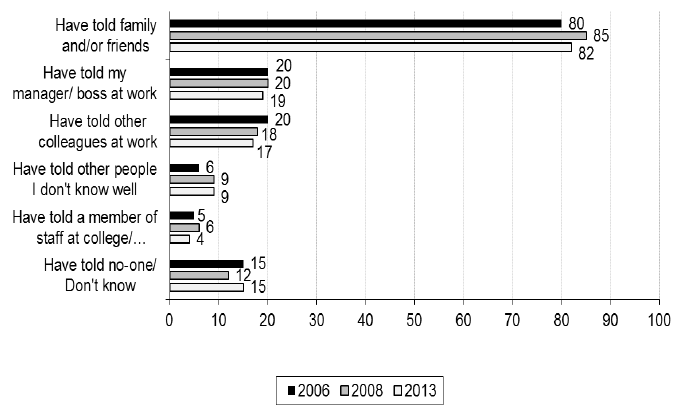
Base: All respondents who identified as having a mental health problem.
Sample size: 2006 = 384; 2008 = 359; 2013=417
2.13 Given that a very large majority (85%) had told someone about their mental health problem, it was not surprising to find that this proportion did not vary significantly across population sub-groups based on socio-demographic characteristics such as age, gender, education, income or area deprivation. However, despite this overall lack of variation, we did find that people with depression were more likely to have told someone about their mental health problem: 91% of people with depression had told someone about their problem, compared with 75% of people who had been diagnosed with other mental health conditions. People with anxiety disorders were also more likely to have told someone about it than those with other mental health problems: 90% compared with 81%.
Social impact of mental health problems
2.14 The Mental Health Strategy for Scotland includes as one of its seven themes, the commitment to continue the anti-stigma work carried out through the 'see me' campaign and to extend this work further to '…focus on the experience of discrimination and exclusion that many people with mental illness experience.' The 'see me' campaign highlights different types of stigma including public stigma, self-stigma and direct discrimination (see also Corrigan, 2012). SSA 2013 captures evidence on all these different dimensions of stigma.
2.15 SSA 2013 asked those who had personal experience of mental health problems about any impacts on their lives due to others' attitudes to their mental health problems. The impacts identified covered examples of both public stigmatisation and direct discrimination. People were asked if they had experienced a range of different impacts including whether they had been discouraged from attending a social event, been refused a job or had been verbally or physically abused. Over a third (37%) of people in 2013 with a mental health problem said they had experienced at least one of the impacts listed in the question. The proportion who said that they had not experienced any of these impacts has changed over time. In 2013, 63% of people with mental health problems had not experienced any of these impacts, a reduction from the 77% recorded in 2008 and a return to levels in 2004 (64%).
2.16 Figure 2.4 shows that 13% of people said they had been discouraged from attending an event. Eight percent of people had been refused a job due to their mental health problems, 5% had been discriminated against at work and 3% had been overlooked or refused promotion. Combining people's responses around work-related discrimination showed that 12% of people felt their mental health problems had led to a negative experience in the workplace or job market. One in 20 people with mental health problems had been verbally abused in the family (5%) and a slightly smaller proportion (4%) had been verbally abused in public (for full details, see Table A.4 in Annex A). There have been no significant changes over time in the proportion who had experienced these social impacts.
Figure 2.4: Social impact of mental health problems (2008 & 2013)
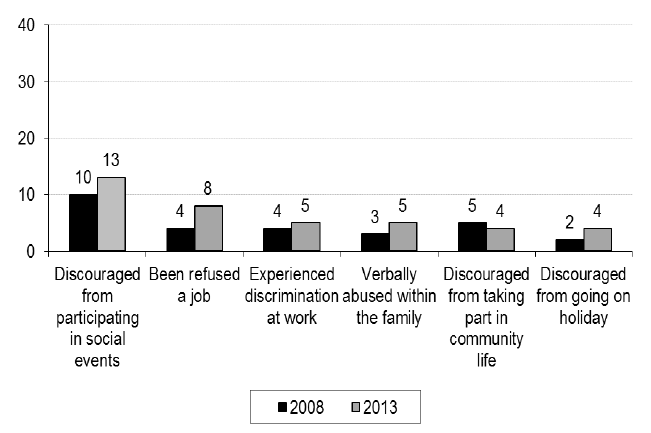
Base: All respondents who identified as having a mental health problem.
Sample size: 2008 = 359; 2013=417
2.17 Men and women had different experiences of the social impact of their mental health problems, as did those on high and low incomes and those with above or below average levels of life satisfaction (for full details see Table A.5 in Annex A). Men were more likely than women to say they have been refused a job (11% of men compared with 5% of women). One in 5 people with a mental health problem in the lowest income group said they had been discouraged from attending a social event compared with only 3% of those in the highest income group. People in the lowest income group were also more likely to have been refused a job and to have been verbally abused by their family than those in the highest income group. Those with a lower than average level of life satisfaction were three times more likely to say they had been discouraged from attending a social event compared with those with average or above average levels of life satisfaction (21% compared with 7%).
2.18 Overall when people with mental health problems were asked whether they had been discouraged from attending an event because of the attitudes of others 13% of people said that they had. In addition a question exploring the potential impact that the anticipation of how others might regard them, and the subsequent possibility of self-stigmatisation, was also included. This question asked whether they had avoided a social event because of the way they thought people would treat them: 22% of people said that they had. This shows that concern about, or the anticipation of, potential discrimination can have a substantial impact on the choices that people with mental health problems make about their participation in social events.
2.19 People on low incomes (Figure 2.5 below) and those with lower than average levels of life satisfaction were more likely to have avoided a social event due to concerns about how others would treat them because of their mental health problem. Thirty-three percent of those in the lowest income group, compared with 9% of those in the highest income group, had done so, and it was reported by twice as many people with low levels of life satisfaction compared with those with average or high levels (31% compared with 15%).
Figure 2.5: Whether avoided a social event by income (2013)
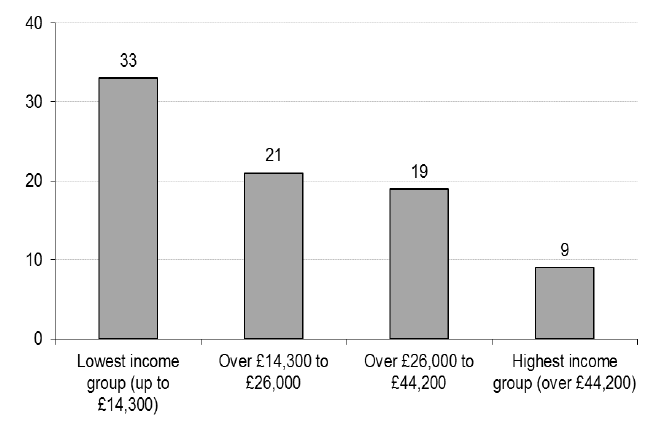
Base: All respondents who identified as having a mental health problem.
Sample size: 417
Contact
Email: Fiona MacDonald
There is a problem
Thanks for your feedback